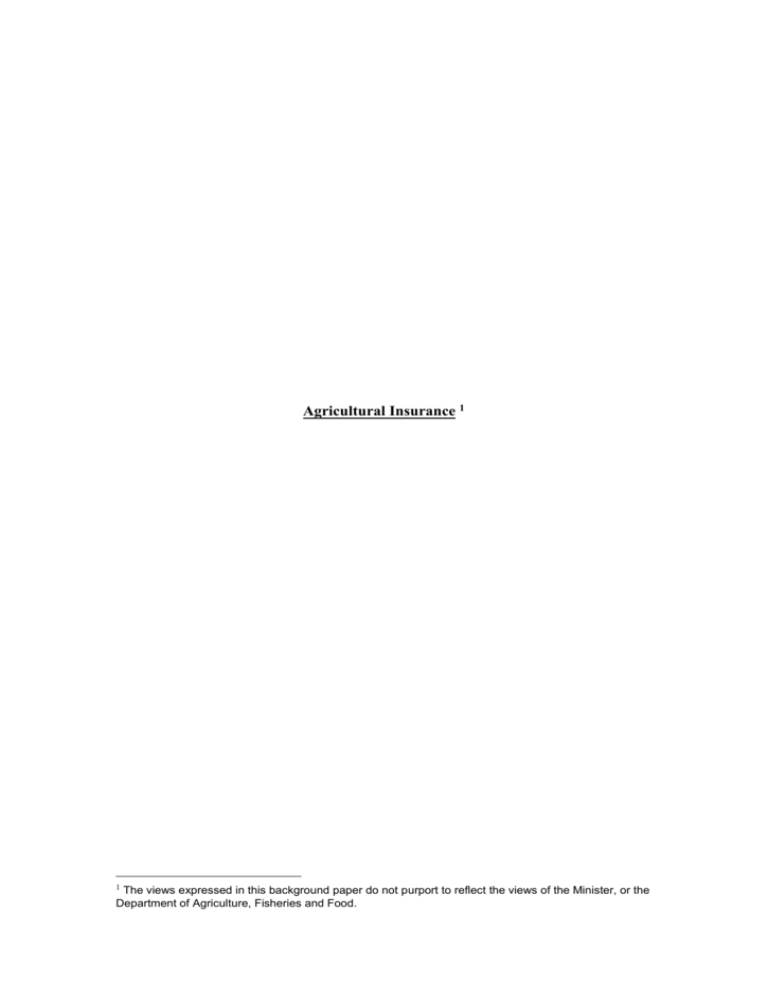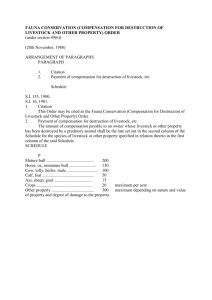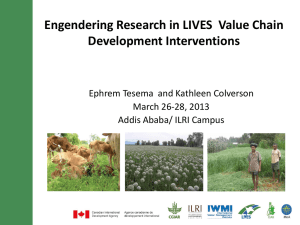5. Agricultural Insurance Systems in Europe
advertisement

Agricultural Insurance 1 1 The views expressed in this background paper do not purport to reflect the views of the Minister, or the Department of Agriculture, Fisheries and Food. 1. Introduction Risk management tools, such as agricultural insurance systems, are common in Europe and the Americas. In Europe, agricultural insurance systems tend to be more common on the continent where they have traditionally been aimed at off-setting the impact of weather variability on crop production. Private insurance systems tend to cover losses from specific natural events that farmers cannot influence, such as hail, drought, floods, etc, or fire and theft of farm assets, death and disability of farmers or farm workers. Most other risks tend to be subsidised under Government insurance schemes as the market determined premia would be too high. The scope of insurance systems have extended somewhat to the livestock sector in recent years, but this is still a relatively underdeveloped area. More comprehensive insurance schemes are available in the Americas covering losses in revenue and net income. This paper looks at approaches taken in Ireland to limit risks, looks at some example of agricultural insurance systems in other countries, as well as policy developments in this area. 2. Current Context In broad terms the development or extent of agricultural insurance schemes seems to be linked to the level of risk, the availability of public support for such mechanisms and the presence or absence of other market support mechanisms. The OECD observes the following relationship between market price support and extent of risk management tools: o Countries with high support levels tend to mainly rely on price support for risk management and offer few other measures. o Countries with moderate levels of market price support make use of variable rate payments such as stabilisation payments, as well as insurance subsidies. o Countries with very low levels of market price support typically have a high incidence of risk management measures. While weather and disease have largely been the focus of agricultural insurance systems to-date, risk is not a static phenomenon. There is a general perception that volatility in temperatures, precipitation and the occurrences of extreme weather events have increased in the past decade. This trend is expected to continue and possibly intensify due to global climate changes. Recent years has also seen greater volatility in agricultural commodity prices, with the hikes in commodity prices evidenced in 2007 and early 2008 reverting rapidly in the latter part of 2008 and early 2009. Medium to long-term forecasts for agricultural commodity markets project higher prices, than their historic average, but, with greater volatility. Modern indoor production systems have reduced weather related risk in the livestock sector. However, this has had the effect of concentrating disease risk. The threat, especially from exotic diseases, is widely perceived to be on the increase also. The OECD identified four potentially important issues likely to change the risk environment for producers: climate change, genetically modified crops, potential disease epidemics in cattle and unexpected policy shocks. With the exception of the disease epidemic risk, these could have either positive or negative consequences from a farming perspective. 3. European Policy Developments in relation to Risk Management At the time of the Health Check negotiations the Commission rejected the notion of an EU wide insurance scheme to cover production risks on a cost basis and due to the wide variation in risks between member states. However, the CAP Health Check did include a provision in Article 68 for national discretion to direct EU funding to insurance and mutual funds2. Despite Commission reservations about the concept of an EU-wide insurance scheme or revenue insurance, there is a trend towards encouraging farmers to take responsibility for production risks. State aid guidelines provide that from 1 January 2010, compensation for losses due to adverse weather effects must be reduced by 50% if the farmer does not have insurance covering at least 50% of annual production or production-related income and the statistically most frequent climatic risks. In addition, the review of the Community Animal Health Strategy, includes proposals for cost sharing mechanisms for animal diseases underpinned by mutual funds. It is anticipated that there will be further discussion about directing resources towards insurance or risk management tools in the CAP post 2013 negotiations, with the Commission expected to increase pressure on Member States to establish schemes to subsidise insurance and the creation of mutual fund e.g. by expanding the conditionality applying to State aid rules. In addition, a number of Member States can be expected to press the introduction of general EU-wide schemes, including France, in the event of a reduction in market support instruments. 4. Risk Management in Ireland Agricultural insurance systems never really developed in Ireland. Pitts (2006) suggested a few reasons: the heavy dependence on animal products (rather than crop products) which were largely covered by EU price guarantees; a relatively mild climate with few extremes and only modest variations in year to year output, and the mechanisms for disease control and eradication, which reduces the risks or incidence of disease. 2 Up to 10% of the Single Payment Scheme (SPS) funds can be used for a number of risk management options including the option for contributions to crop, animal and plant insurance premiums (Article 70) and/or mutual funds for animal and plant diseases and environmental incidents (Article 71). 4.1 Livestock Sector Two-thirds of Irish agricultural output is from cattle either as beef or dairy products; such commodities have historically been supported through various price support mechanisms and direct payments in more recent years. Such support insulates their income from much of the impacts of market and price volatility and would limit the requirement for insurance type systems. With the concentration of Irish agricultural production in livestock and milk production the main risk facing the sector is from livestock diseases. Consequently the main risk management measures in place in Ireland are the various disease control and eradication programmes. The most significant of these in terms of costs are schemes for the control and eradication of Bovine Tuberculosis and Brucellosis3. Compensation to producers accounts for less than half of gross expenditure under the control programmes. The programmes have a number of components including research, surveillance, wildlife control, administration, testing, removal of infected animal, compensation payments to herd owners, veterinary post-mortems and inspections in slaughter houses. Expenditure on these schemes has reduced in recent years due to the effectiveness of the programmes at reducing the incidence of disease. The cost of the programmes was over €60 million in 2008. The programmes are funded by both public funds and the farming community who contribute through disease levies imposed at points of slaughter for cattle and on milk deliveries. Annex 1 contains details of total costs, compensation payments and disease levies paid by producers in the period 2000-2008. The programmes are also underpinned by a range of cross-cutting supports, including quality control, herd registration, animal identification and tracing and computerised management of testing and disease information, which would also have additional costs which are borne by the state. The conclusion from Pitts (2006) is that the Irish disease eradication schemes are effective at reducing the exposure to animal disease risks and consequently reduces the demand for insurance related measures in Ireland. Maintenance of such programmes was also found to be essential in providing the necessary guarantees to allow Irish cattle and their products access to EU third-country markets (O’Flaherty, 2008) 4. 4.2 Crop Sector Fluctuations in output are more evident in the crops sector. Cereal production accounts for 4% of gross output in Ireland. Due to issues of soil type, as well as poor growing condition in the North and West, this production is limited to 300,000400,000 hectares mainly in the south-east of the country. Large annual variations tend 3 There are also a number of other livestock disease programmes covering BSE, Scrapie, Equine Infectious Anemia, Blue Tongue, FMD, Johnes, Newcastle disease (poultry) and Aujesky’s (pigs). The cost of monitoring these programmes tends to be smaller, estimated at approximately €15 million from year to year, but this figure is more variable from year to year. 4 O’Flaherty, J. (2008), Money and policy review of the Bovine Tuberculosis Eradication Programme. to be most evident in the potato sector, where some type of insurance system may be worthy of consideration. 4.3 Other Activities to Diversify Risk A number of other activities are common in Ireland which diversify or spread some of the inherent risk in agriculture. One method of spreading risk is by diversifying sources of income, through off-farm employments and alternative enterprises etc. Off-farm employment is common in Ireland, especially in sectors where lower family farm incomes are evident. EU-SILC data for 2006 shows that farm income accounts for approximately half of total farm household income, with the rest comprised of other earned income, social transfers and/or investment income. In Ireland there are special provisions for farm families through the social welfare systems. A Farm Assist scheme is available through the social welfare system to supplement low income farm families. While the scheme is generally geared toward families with consistently low incomes it has been adapted on occasions to cater for shorter-term crises in the farming sector. Through the taxation system farmers5 can opt for income averaging of tax returns, which helps to even out some of the annual fluctuations in farm incomes. This is particularly suited to situations where volatility in income is expected or the norm. On a number of occasions ad hoc payments have been made following a crisis in the sector. For instance, payments were made to producers following exceptionally wet weather and related fodder difficulties in the late 1990s, the foot and mouth crisis in 2001 and a dioxin incident in 2008. Other solutions to weather and/or market difficulties have been to bring forward payments of EU direct payment schemes. 5. Agricultural Insurance Systems in Europe In the EU there is a high level of support for the agriculture sector, with various CAP instruments reducing the level of income variability faced by farmers. However, in addition to these measures most countries have specific measures designed to help farmers manage risk, either by preventing or reducing its occurrence (e.g. vaccination programmes) or reducing its consequences (e.g. insurance/futures/income smoothing). With regard to insurance type schemes, the level and extent of coverage and subsidisation can vary widely from country to country with programmes down to regional level in some European countries. In 2004, it is estimated that 23% of EU-27 crop value was insured. Premiums amounted to €1,583 million or 4% of the insured value and subsidies amounted to 32% of premiums. Some examples of agricultural insurance type schemes in European countries are detailed in this section. 5 There are restrictions on eligibility to income averaging. 5.1 Spain In Spain, agricultural insurance policy is decided centrally providing guidelines to autonomous regions, which can apply it to suit their own needs. The Spanish system is based on the following principles: universal application: every effort is made to cover as many risks, farmers and area as possible; voluntary purchase: nobody is forced to purchase insurance; insurance is your responsibility: emergency aid will not be paid for disasters where the risk was insurable, while insurance companies cannot refuse to insure someone for an identifiable risk; full coverage: those seeking insurance must cover their entire holding. Some 70% of agricultural insurance policies are for non-livestock sectors, reflecting the relative importance of crop production in Spain. Insurance was extended to the livestock sector to cover the risk of injury to animals in the 1990’s. Livestock insurance is only available as a comprehensive package, that is, all animals must be covered for the specific risk. More recent insurance schemes allow cover for BSE, foot and mouth disease, blue tongue and swine fever. Fallen animals are insured by a complicated system, involving central, regional and private funding with each region deciding on the level of support that they will provide. It is reported that in some regions the state pays up to 80% of insurance costs with reports of up-take being as high as 93% in places. The state is promoting the idea of a single policy to cover all risks (accidents, disease, public liability, buildings fire, theft, etc). 5.2 United Kingdom In the UK the private insurance sector provides conventional hail insurance coverage. There is no government involvement and price and yield risks are not covered by insurance. In relation to livestock, the Government provides compensation for the compulsory slaughter of livestock following specific infectious diseases. However, the private insurance sector also provides for insurance cover for certain diseases to top-up the Government compensation where compensation is provided, and to provide indemnity for the slaughter of livestock where no compensation is available. Diseases covered by the insurance sector includes foot and mouth, tuberculosis, brucellosis and classical swine fever. The total number of animals covered by private sector insurance companies is approximately 1,280,000 representing 2.6% of total cattle, sheep and pig herds. Production value covered by insurance in the UK is €760 million. 5.3 Italy Current risk management policy in Italy is attempting to introduce and promote new types of insurance cover, while at the same time, rationalise public expenditure on compensation. Every year, each region specifies the coverage, products and municipalities for which they are going to allow subsidised insurance and which will therefore, be excluded from any grants of compensation. Farmers are not obliged to take out insurance, it is voluntary. Subsidies policies were extended to cover cattle and buffalo farms in 2006, previously policies had been limited to crops and structures. Diseases covered by insurance included foot and mouth brucellosis, pleuropneumonia, tuberculosis and enzootic leucosis. Compensation is paid for the value of the animal (excluding any other state contribuition to compensation), it also covers loss of revenue for the period of stoppage of the farm and the costs of disposing of dead animals (again excluding any other State contribution). 5.4 Greece Insurance is compulsory for farmers. ELGA (an independent State organisation) provides insurance type products for crop and livestock against a number of risk factors giving full coverage of crop production and livestock in Greece. Crops are covered against hail, frost, windstorm, flood, excessive heat, excessive or out of season rainfalls, snowfall, sea water and damages caused by bears and wild boars. Generally losses up to 20% per crop and per field are not covered. As well a losses arising from climatic incidences, livestock are covered for losses caused by wild animals and the following diseases: anthrax, blackleg, viral diarrhoea, malignant catarrhal fever, gangrenous mastitis, pathological dystokia, contagious agalactia. There is also private insurance in Greece although this market is less developed. It includes a hail crop insurance and livestock mortality insurance for bovines, sheep, goats, pigs and poultry. 6. Agricultural Insurance Systems in Non-European Countries Many non-EU countries have private agricultural insurance systems covering losses from specific natural events that farmers cannot influence, such as, hail, drought, floods etc. Less common are multi-risk, crop insurance schemes, which compensate for losses in yield, whatever the cause. Canada and the United States are examples of countries where comprehensive insurance schemes are available covering losses in revenue or net income. 6.1 United States Agricultural insurance systems are well developed in the USA, with multi-peril insurance available for over 100 crops. Premia are heavily subsidised with farmers paying a flat fee plus and a proportion of any buy-ups beyond a basic level of risk6. Insurance is based on recent yield history, price forecasts and futures contracts. The indemnity is paid if yields or revenue falls below the guaranteed level of output value. The acreage insured has increased in recent years and farmers have been opting for higher levels of insurance. Policies are sold and administered by private insurance companies, which in turn receive an administrative subsidy based on their number of contracts. The Government provides the first level of re-insurance. The USA are currently trying to expand insurance to the livestock sector. 6 The basic level of coverage is for catastrophic risk, that is, 50% yields at 55% price, and buy-ups are available up to 85% yield and 100% price. The most recent US Farm Bill has provided for a new Average Crop Revenue Election (ACRE) program over the period 2009-2010. In brief, in integrates aspects of commodity supports and direct payments, paying farmers when revenues drop below normal revenue levels. This contrasts with direct payments, which are paid regardless of market returns or whether or not there has been a drop in yield or prices. Under ACRE, farmers accept a 20% sacrifice on direct payment and a 30% reduction in the marketing loan rate for a guarantee on revenue. However, the guarantee is set at state level rather than at individual produce level, so an individual farmer who suffers a catastrophic loss would not receive compensation unless the loss was reflected in the total output or revenue of the state. 6.2 Canada In Canada, production insurance is available for a range of crops as well as a more comprehensive Canadian Agricultural Income Stabilisation programme (CAIS). Production insurance has been available for the past 40 years on a voluntary basis for farmers. The cost is shared between producers and Government (at both federal and provincial level). Provincial governments take responsibility for programme design and delivery, while the Federal Government contributes to premiums, administrative costs and re-insurance to some provincial agencies. Over half of Canadian farmers are insured covering 65%-70% of crops. Whilst single and multi-peril insurance on crops and assets are available, market failure or price declines are not insured. CAIS is based on a whole farm approach rather than commodity specific support. When farmers’ income or ‘‘production margin’’ fall below their recent average (last five years excluding the highest and lowest) producers are eligible for compensation. The level of compensation depends on the magnitude of the loss, with smaller losses generally shared equally by producers and the Government, while a larger proportion of higher losses are borne by the Government. Losses are based on annual tax returns. 7. Issues for Ireland to Consider in Relation in Risk Insurance While the overall level of risk facing Irish producers would heretofore have been assessed as relatively low, this may change over the coming decade. A large share or Irish agricultural output (mostly related to meat and dairy production) has traditionally been covered by EU market support mechanisms which ensures that EU prices are less volatile that world prices. However, EU support systems are changing with reduced emphasis on price levels for buying-in under public intervention. This is likely to lead to agricultural income and price volatility as experienced in the past two years on dairy and cereals. The future of direct payments also need to be factored in to the consideration of risk insurance. The level of income insulation provided by direct payments is likely to be diminished over time as increases in inflation erode the value of payments, which on balance, are more likely to be subject to cuts than increases. The reduced role or emphasis on direct payments as well as a reduced emphasis from the Commission on other forms of market management measures will increase the exposure of the sector to the impact of market price volatility Although world markets fluctuations remain more volatile than European markets, and are likely to remain so, there is a general consensus that the exposure of European markets to this type of volatility will increase further over the coming decades with consequences for producer and retail prices. As a major exporter of agricultural commodities, Ireland is likely to feel the impact of this increased volatility more so than many other European countries. This would indicate an increased need for insurance type products to guard against market losses in the future. In addition, our high levels of trade with the UK means we are more exposed to exchange rate fluctuations with sterling. The rapid decline in the value of sterling seen at the end of 2008 and the enormous competitive pressure this put on Irish suppliers is evidence of how exchange rate volatility could compound markets difficulties in the future. While overall climatic conditions in Ireland are relatively moderate with few incidences of extremes, there is a general perception that extreme weather events have increased in the past decade and that this trend is likely to continue and possibly intensify. While overall climatic changes could be either positive or negative from Ireland’s perspective, the potential for insurance type products in guarding against weather related losses/damages is worthy of consideration. State Aid rules, which from 2010 will link compensation for losses due to adverse weather conditions to the up-take of insurance, also make this consideration more pertinent. With the bulk of Irish agricultural output in livestock and milk production the main risk facing the sector would be from animal diseases. While the current disease control and eradication schemes are effective in managing such risks and the current arrangements for sharing the cost of compensation paid under these schemes appears to be acceptable, to potential of insurance in this area would also merit consideration, especially in the likelihood that there will be an increased threat from exotic diseases, as evidenced by the Bluetongue outbreaks in Europe over the last few years. Fluctuations in output arising primarily from variability in weather conditions are more evident in the crops sector. Again, given the State Aid conditions attached to compensation payments for the post 2010 period, the need of having some type of insurance product available should be assessed. Conclusion In light of the perceived changes to the level of risk facing the agriculture sector as well as the Commission’s desire to reduce emphasis on market management measures the need for insurance type products appears be on the increase. The insurance products available in other countries provide an indicator of the types of products available that could potentially have some application here. Many European countries have insurance products available to guard against weather related losses and are gradually expanding schemes to cover disease risks in livestock. The US and Canada provide examples of more comprehensive insurance products, with the US offering a scheme where farmers forego a portion of their direct payments for a guarantee on revenue. Given the changing risk environment the potential application of agricultural insurance schemes in Ireland merits serious consideration. Annex 1. TB and Brucellosis Eradication Schemes Expenditure and Levies 20002008 Year Gross Compensation Expenditure Expenditure Bovine Disease Levies (Receipts) 1 €m Outturn €m €m 2000 74.5 46.81 11.7 2001 63.9 40.87 10.4 2002 76.6 48.00 11.0 2003 65.0 36.67 19.8 2004 53.1 26.80 16.9 2005 50.3 21.37 11.4 2006 45.7 17.5 10.5 2007 49.1 19.3 6.2 2008 62.0(est) 27.0(est) 1 5.0(est) Gross Expenditure includes testing, travel and subsistence, the cost of wildlife control, research etc. Source: DAFF (ERAD Division)






